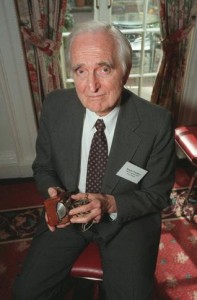Douglas Engelbart, whose invention of the mouse transformed the way people interact with computers, has died.
The mild-man nered Engelbart had audacious ideas. Long before Apple founder Steve Jobs became famous for his dramatic presentations, Engelbart dazzled the industry at a San Francisco computer conference in 1968.
nered Engelbart had audacious ideas. Long before Apple founder Steve Jobs became famous for his dramatic presentations, Engelbart dazzled the industry at a San Francisco computer conference in 1968.
Engelbart died Tuesday night at his home in Atherton, California, SRI International — the research institute where he once worked —said in a statement. He was 88.
A radar technician during World War II, Engelbart worked at the Stanford Research Institute during the 1960s. It was there that a vision of people sitting in front of a video screen, interacting with a computer, came to him.
Back in the 1950s and ‘60s, when mainframes took up entire rooms and were fed data on punch cards, Engelbart already was envisioning a world in which people used computers to share ideas about solving problems.
He said his work was all about “augmenting human intellect,” but it boiled down to making computers user-friendly.
One of the biggest advances was the mouse, which he developed in the 1960s and patented in 1970. At the time, it was a wooden shell covering two metal wheels: An “X-Y position indicator for a display system.”
The notion of operating the inside of a computer with a tool on the outside was way ahead of its time. The mouse wasn’t commercially available until 1984, with Apple’s new Macintosh.
In fact, Engelbart’s invention was so early that he and his colleagues didn’t profit much from it. The mouse patent had a 17-year life span, and in 1987 the technology fell into the public domain — meaning Engelbart couldn’t collect royalties on the mouse when it was in its widest use. At least 1 billion have been sold since the mid-1980s.
Among Engelbart’s other key developments in computing, along with his colleagues at Stanford Research Institute (SRI) and his own lab, the Augmentation Research Centre, was the use of multiple windows. Engelbart’s lab also helped develop ARPANet, the government research network that led to the Internet.



